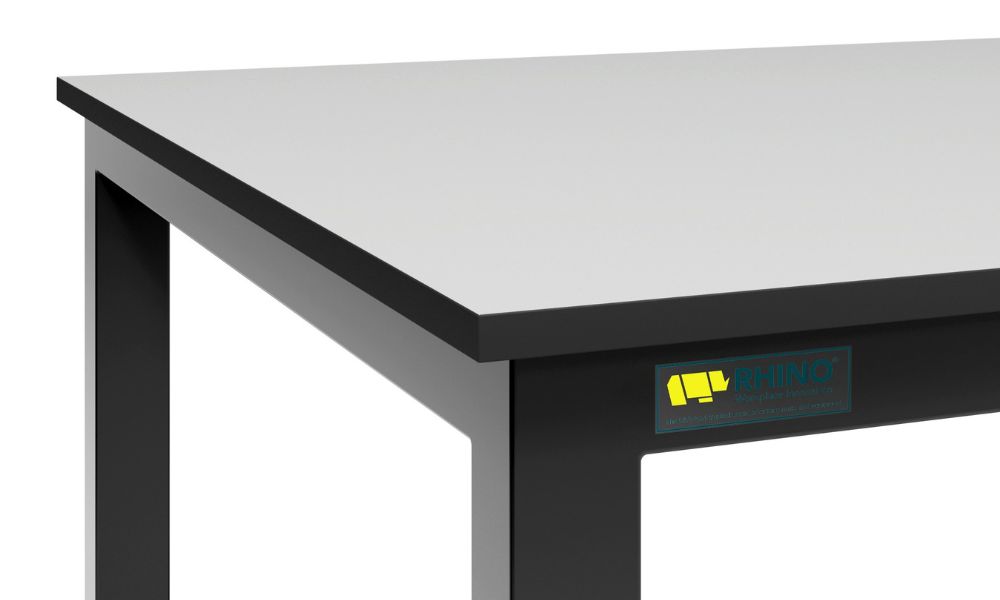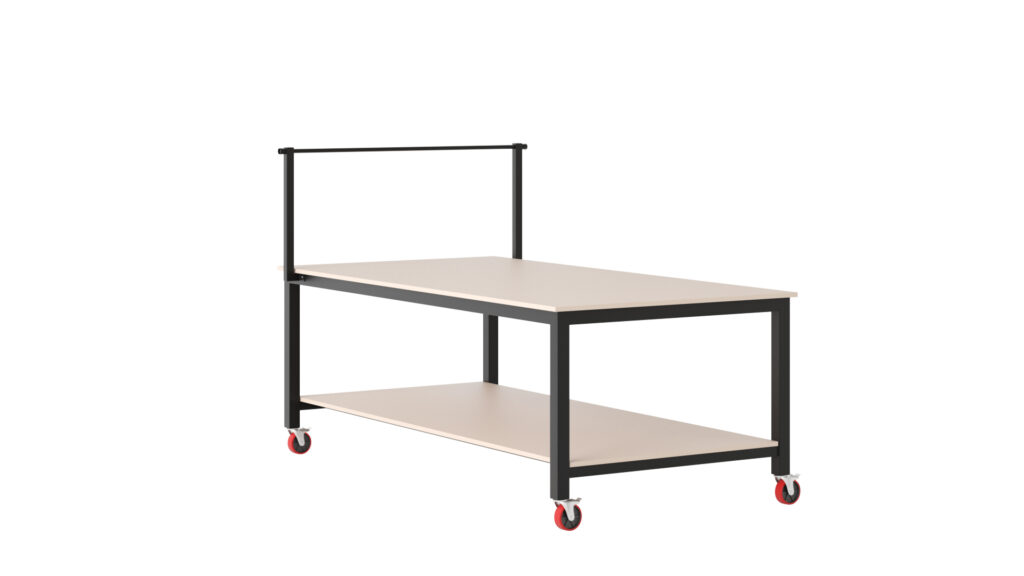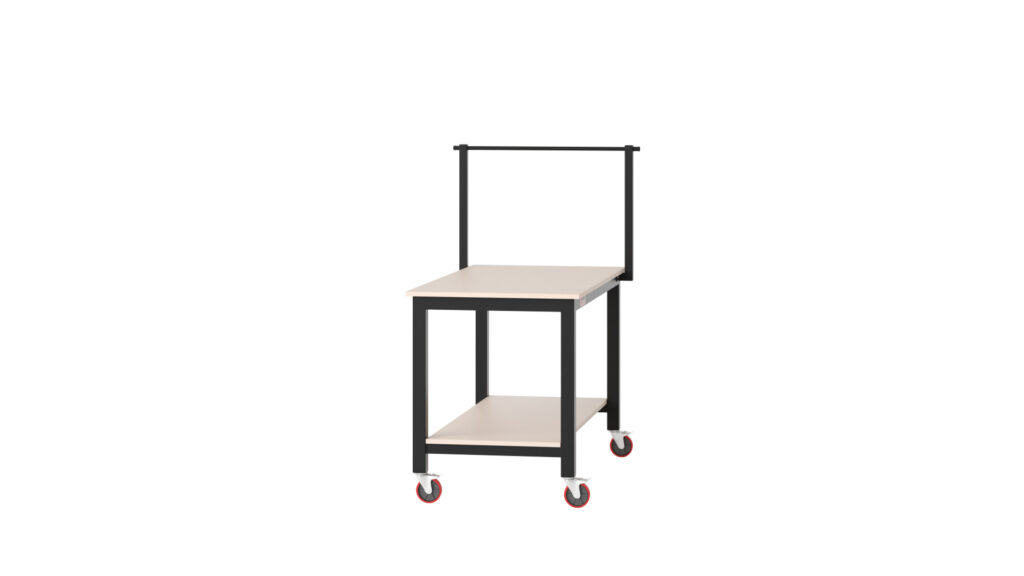Creating a Multi-Functional Workspace: Tips for Combining Fixed, Adjustable and Demountable Benches

Does your workspace keep up with your projects, or does it slow you down? One day you’re cutting materials, the next you’re assembling parts, and clutter piles up fast. A multi-functional workspace helps you stay organised while saving time.
It’s not about squeezing in another table. It’s about planning your space so it adapts to different tasks with the right workbench combinations. With smart industrial workspace planning, you can set up zones for heavy cutting, flexible assembly and easy tool access without wasting time shifting things around.
A well-planned workspace makes your day smoother. You can walk in, start working and keep your focus on the job, not on cleaning up or hunting for tools.
In this guide, we’ll show you how to create a multi-functional workspace with practical workbench combinations you can set up in any shop, big or small.
Why a Multi-Functional Workspace Matters
A multi-functional workspace isn’t just a trend; it’s a practical way to keep up with the demands of modern projects. When you have a setup that adapts to different tasks, you cut down on wasted time and reduce stress during busy days.
Think about those moments when you need to move from cutting materials to assembling parts. If your workspace can’t adjust, you’ll end up shifting tools, clearing benches or working in cramped corners. With the right workbench combinations, you can move from task to task without stopping your workflow.
Good industrial workspace planning helps you make the most of your available space. It can mean setting up a heavy-duty bench for cutting, an adjustable bench for assembly and a mobile bench for flexible work. This setup keeps your tools close and your surfaces clear.
A multi-functional workspace supports:
- Better workflow: Switch tasks without clearing everything off your bench.
- Less clutter: Each zone has a purpose, reducing piles of tools and materials.
- Improved safety: Clearer paths reduce trip hazards while working.
When your workspace works with you, it feels easier to get projects done. A flexible layout doesn’t need to be complex or costly. Even small changes, like adding an adjustable bench or planning tool zones, can transform your day-to-day tasks.
Understanding Workbench Options for Your Workspace
Creating a multi-functional workspace starts with understanding the types of benches you can add. The right workbench combinations can shape how efficiently you move through projects while keeping your space organised. Here’s a closer look at the options to consider during your industrial workspace planning.
Fixed Benches: The Foundation of Stability
Fixed benches are perfect for tasks that need a sturdy surface. If you cut large materials, use heavy tools or work with machines, a solid bench keeps your work steady and safe. These benches don’t move, so you can add a vice, drill press or cutting mat without worrying about shifting surfaces.
Fixed benches are best placed along walls or in corners. This way, they act as anchor points in your multi-functional workspace, letting you handle heavy jobs without cluttering your main work area.
Adjustable Benches: Flexibility When You Need It
Adjustable benches help you work comfortably, whether you’re sitting or standing. If you pack orders, assemble products or handle small batch tasks, these benches make it easier to adjust your workspace to the task.
During industrial workspace planning, consider adjustable benches in areas where you often switch between detailed work and heavier tasks. You’ll reduce strain on your back and keep your workflow smooth.
For example, adjusting your bench height while cutting on a Rhino cutting mat can help reduce fatigue, especially during long projects.
Demountable Benches: Adaptable and Mobile
Demountable benches add flexibility to your workbench combinations. These benches are easy to move, so you can clear space for larger projects or team work when needed. They’re helpful in seasonal workflows or workshops with limited floor space.
When planning your multi-functional workspace, place demountable benches in the centre of your workshop or near shared tool areas. This lets you quickly adapt your layout without heavy lifting or complex rearrangements.
Mobile Heavy Duty Benches: Strength Meets Mobility
Mobile heavy duty benches combine strength with manoeuvrability, giving you a tough surface you can reposition with ease. Built to handle the demands of industrial tools, machinery or repetitive assembly, these benches are fitted with locking castors to ensure they stay put once in place.
They’re ideal in dynamic work environments where projects move between zones or where flexibility is key without compromising on load capacity. Use mobile heavy duty benches to shift operations smoothly without disrupting your setup or sacrificing durability.

Industrial Workspace Planning: Setting Up for Success
Good industrial workspace planning helps your shop run smoother, no matter its size. It’s not just about moving benches around. It’s about creating a multi-functional workspace that fits your workflow, keeps you organised and makes every task easier.
Start by measuring your space. Knowing your floor area helps you plan where each bench will go without blocking walkways. Sketch a simple layout on paper if needed. Think about how you move between cutting, assembling and packing so you can place benches where they save time.
Keep your heavy fixed benches along walls or corners. Place adjustable benches where you handle detailed work. Use demountable benches in the centre for flexible projects or overflow tasks. This simple zoning keeps your workbench combinations practical and clear.
Lighting matters, too. If you often cut on your Rhino cutting mat, add task lighting above your main benches to reduce shadows and eye strain. Good lighting is part of industrial workspace planning you shouldn’t skip.
A few small changes can make your multi-functional workspace feel ready for anything:
- Label bench zones for cutting, assembly and packing
- Use under-bench storage to keep tools close but off surfaces
- Keep paths clear to reduce tripping hazards
- Add bins for scraps near cutting areas
Planning your workspace doesn’t have to be complicated. It just takes a bit of thought about how you work now and how you’d like to work moving forward. Once you have a clear layout, your multi-functional workspace will support your projects instead of slowing them down.

Creating Effective Workbench Combinations
Building a multi-functional workspace is easier when you choose the right workbench combinations for your tasks. Pairing benches correctly can save time, reduce clutter and help you keep your projects moving. With a bit of industrial workspace planning, your layout will work with you, not against you.
Zoning Your Multi-Functional Workspace
Zoning helps you decide where each bench fits best. Place fixed benches against walls for heavy cutting or tool mounting. Use adjustable benches in open areas for tasks that change, like assembly or packaging. Demountable benches fit well in the centre or near shared tools, so you can move them as needed for bigger projects.
For example, if you often cut on your Rhino cutting mat, place your fixed bench in a well-lit corner with clear space on each side. Keep your adjustable bench nearby for quick transitions to assembly without dragging materials across your shop.
Matching Bench Types with Task Types
Choosing the right bench for each job helps your multi-functional workspace stay clear and organised. Here’s a simple guide:
Task | Recommended Bench | Why it Works |
Cutting or heavy assembly | Fixed bench | Stability for precise tasks |
Packaging and light assembly | Adjustable bench | Comfortable height changes |
Overflow or team projects | Demountable bench | Easy to move as needed |
Using this approach during your industrial workspace planning keeps tasks flowing while reducing unnecessary movement around your shop.
Safety and Cable Management
Don’t overlook safety while planning your workbench combinations. Keep cables tied and out of walkways to prevent trips. If you use power tools, check cable lengths before moving your demountable benches. You can use under-bench trays or hooks to store extension leads neatly.
Keeping walkways clear is part of having a multi-functional workspace that’s safe and productive. A tidy layout helps you focus on your projects instead of stepping over cords or tools.
With these practical tips, you can set up workbench combinations that support your daily tasks and long-term projects. A bit of planning now will help you keep your multi-functional workspace flexible and ready for whatever you build next.
Maintaining a Multi-Functional Workspace
Keeping a multi-functional workspace organised takes small, steady habits. Once you’ve set up your workbench combinations, it’s important to maintain them so your space stays clear and ready for every project.
Start with a daily clean-down. At the end of each workday, clear tools from benches and return them to their zones. Wipe down surfaces, especially your Rhino cutting mat, to keep it ready for tomorrow’s tasks. This quick routine keeps clutter from building up.
Use labels or colour-coded tape to mark bench zones. It helps you remember where each tool belongs and makes it easier to find what you need during busy days. If you share your workspace, labels help everyone keep the system in place.
Here are a few simple maintenance tips:
- Keep a small bin near each bench for offcuts and scraps
- Use hooks under benches for frequently used hand tools
- Check adjustable benches weekly for loose parts
- Return demountable benches to their storage spot after use
During your industrial workspace planning, you may have set up under-bench storage. Make the most of it by using trays or small bins to organise screws, blades and accessories.
Maintaining your multi-functional workspace also means reviewing your layout occasionally. Every few months, check if your workbench combinations still match your workflow. If you find you’re shifting tools often or working in cramped areas, it might be time to rearrange your benches to improve your workflow.
These small steps keep your multi-functional workspace practical, tidy and ready for your next project.
Budgeting for Your Multi-Functional Workspace
Planning a multi-functional workspace doesn’t need to drain your wallet. With smart choices, you can build workbench combinations that fit your budget while improving your workflow. Good industrial workspace planning helps you invest where it counts without wasting money on setups you won’t use.
Start by listing your daily tasks and the benches you need for them. This helps you avoid buying benches that won’t get regular use. If you mainly cut materials, a sturdy fixed bench and a Rhino cutting mat may take priority. If you package or assemble products often, an adjustable bench can be a better first investment.
When you plan your budget, consider:
- Fixed benches: Generally cost less and last longer for heavy work.
- Adjustable benches: Mid-range in cost but offer flexibility for changing tasks.
- Demountable benches: Often higher in price due to mobility but save space.
You can also save by adding benches gradually instead of all at once. Start with a fixed bench to handle your core work, then add an adjustable or demountable bench when your workflow grows.
Here’s a simple budgeting checklist for your multi-functional workspace:
- Assess your space and needs before buying
- Prioritise benches that match your daily tasks
- Allocate a portion for quality cutting mats and tool storage
- Plan for lighting to avoid working in shadows
- Keep a small fund for future bench adjustments
Remember, a flexible workspace is a long-term investment. Spending wisely on the right workbench combinations now will help you avoid costly rearrangements later.
Building a multi-functional workspace isn’t about making your shop look busy. It’s about creating a clear, practical space that helps you work better every day. By planning your workbench combinations carefully, you can move between cutting, assembly, and packing without wasted steps or clutter.
Smart industrial workspace planning helps you use your space well, whether you’re working in a small garage or a larger workshop. By choosing the right benches, maintaining them and keeping your layout tidy, you’ll find your projects run smoother, and your workspace feels ready for any task.
Ready to protect your benches while keeping your workflow clear? A Rhino cutting mat helps you cut confidently without damaging your work surfaces, making it a simple but essential addition to your multi-functional workspace.
FAQs
1. What is a multi-functional workspace?
A multi-functional workspace is a flexible area that supports different tasks without needing constant rearrangement. It can include workbench combinations like fixed benches for heavy work, adjustable benches for assembly, and demountable benches for mobile tasks. This type of setup helps you stay organised and productive.
2. How many benches do I need for a small workshop?
It depends on your daily work. For most small workshops, starting with one fixed bench and one adjustable bench is enough. If you handle seasonal projects or need more flexibility, adding a demountable bench later can help. Smart industrial workspace planning will help you get the most out of your available space without overcrowding it.
3. Can I convert a fixed bench into an adjustable bench?
Not easily. Fixed benches are built for stability, while adjustable benches are designed with moving parts and adjustable height mechanisms. It’s often better to buy or build a separate adjustable bench rather than modify a fixed one. This keeps your multi-functional workspace safe and practical.
4. Are demountable benches strong enough for heavy tasks?
Many demountable benches can handle moderate tasks, but they may not match the stability of a fixed bench for heavy cutting or hammering. Use your demountable bench for flexible, lighter tasks, and keep your heavy work on your fixed bench with a Rhino cutting mat for protection.
5. How can I maintain clear paths in a multi-functional workspace?
Clear paths are key for safety and workflow. Keep your bench areas tidy by using under-bench storage and hooks for tools. Return demountable benches to a designated spot when not in use. As part of your industrial workspace planning, measure walkways to ensure you have space to move freely even when benches are in use.
6. Do I need all three types of benches to have a multi-functional workspace?
No, you don’t need all three to start. Many workshops begin with a fixed bench and add an adjustable bench later. A demountable bench is a useful addition when you need more flexibility. Over time, you can expand your workbench combinations based on your workflow and budget.
